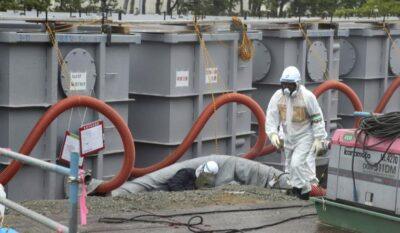
Image source: IBTimes.com
It may be hard to believe, but major leaks of potentially deadly radiation have been discovered at Japan’s Fukushima Daiichi nuclear power plant, two years after the tsunami.
Tokyo Electric Power Co. (TEPCO) reported in mid-October that in one day alone, the amount of toxic substance found in the water around the plant spiked 6,500 percent — 400,000 becquerels per liter from just 61 found the day before. The radioactive groundwater appears to be spreading, TEPCO said.
The latest news follows a report from the summer that found radioactive water contaminated after the plant was destroyed by the 2011 tsunami was leaking from several tanks and likely had leaked into the Pacific Ocean. There are about 300 similar tanks at the facility according to the Japanese Nuclear Regulation Authority.
The water was stored in hastily built tanks around the plant after it shut down.
To make matters worse, the Tokyo Electric Power Company, or TEPCO, which owns and operates the plant, hasn’t reported leaks promptly to authorities nor to the public.
Poorly Built Tanks
The hastily built tanks may not have adequate foundations to prevent leaks and ground water contamination, said Shunichi Tanaka, the authority’s chairman. Tanaka also said that there is now up to 330,000 tons of contaminated water stored at Fukushima and that the amount of contaminated water there increases by around 400 tons every day.
Ultra Efficient Water Filter Fits In Your Pocket!
The amount of radioactive water leaking from Fukushima could contaminate so much water that it could destroy the Japanese fishing industry. Executives with an association that represents Japanese fishing companies made that assertion to the Associated Press.
The radiation has already created a major panic in Japan, where people are shunning seafood. Seafood is a major part of the Japanese diet and part of its economy. Octopus is being eaten, but not much else.
“It seems like we took one step forward and as soon as things were getting brighter, the leakage put a damper on it,” said fisherman Hiroaki Adachi.
The situation at Fukushima is growing steadily worse, according to the Nuclear Regulation Authority. The agency recently upgraded the Fukushima catastrophe to a Level Three radiological event on a scale put out by the International Atomic Energy Agency. That means the contamination there is three times worse than was previously thought.
Tanaka also said that his agency was unable to stop the leaks and that the amount of contaminated water leaking into the sea cannot be determined.
Could a similar situation take place in America, particularly after an earthquake?
Many of America’s nuclear power plants are located in agricultural areas, especially in the Midwest and South, according to a map published by the United States Nuclear Regulatory Commission. A glance at the map shows that one of the largest clusters of nuclear plants is in the area around Chicago — right in the heart of America’s breadbasket.
A Fukushima-style catastrophe could contaminate cropland, because nuclear power plants use large amounts of water to cool the reactors. If the water got contaminated and started leaking into the ground as at Fukushima, it could contaminate aquifers and crops. Many American farmers using aquifer groundwater to irrigate crops.
Read more about Radiation Level Spikes 6,500 Percent At Japan’s Fukushima Nuclear Plant

No comments:
Post a Comment